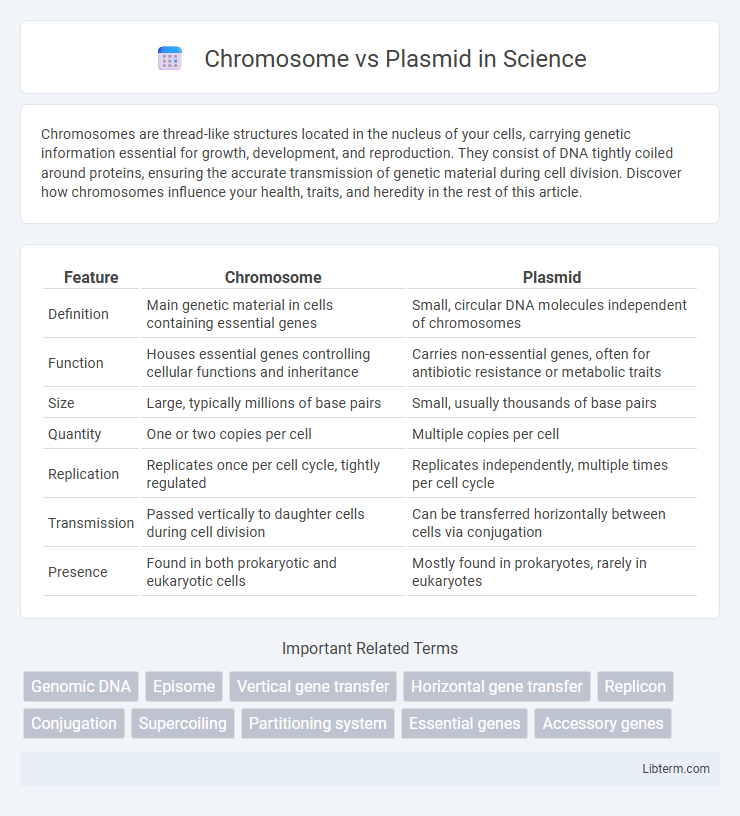Chromosomes are thread-like structures located in the nucleus of your cells, carrying genetic information essential for growth, development, and reproduction. They consist of DNA tightly coiled around proteins, ensuring the accurate transmission of genetic material during cell division. Discover how chromosomes influence your health, traits, and heredity in the rest of this article.
Table of Comparison
| Feature | Chromosome | Plasmid |
|---|---|---|
| Definition | Main genetic material in cells containing essential genes | Small, circular DNA molecules independent of chromosomes |
| Function | Houses essential genes controlling cellular functions and inheritance | Carries non-essential genes, often for antibiotic resistance or metabolic traits |
| Size | Large, typically millions of base pairs | Small, usually thousands of base pairs |
| Quantity | One or two copies per cell | Multiple copies per cell |
| Replication | Replicates once per cell cycle, tightly regulated | Replicates independently, multiple times per cell cycle |
| Transmission | Passed vertically to daughter cells during cell division | Can be transferred horizontally between cells via conjugation |
| Presence | Found in both prokaryotic and eukaryotic cells | Mostly found in prokaryotes, rarely in eukaryotes |
Introduction to Chromosomes and Plasmids
Chromosomes are large, linear or circular DNA molecules that carry essential genetic information required for the growth, development, and reproduction of an organism. Plasmids are smaller, circular DNA molecules found primarily in bacteria, independent of chromosomal DNA, and often contain genes that confer advantageous traits such as antibiotic resistance. Both chromosomes and plasmids play critical roles in genetic regulation and horizontal gene transfer, but chromosomes house the core genome while plasmids provide adaptable genetic advantages.
Defining Chromosomes: Structure and Function
Chromosomes are long, thread-like structures composed of DNA and proteins, primarily histones, that organize genetic material within the nucleus of eukaryotic cells or in the nucleoid region of prokaryotic cells. They carry essential genes that regulate cellular functions, inheritance, and development by ensuring precise replication and segregation during cell division. Unlike plasmids, chromosomes are typically larger, contain most of an organism's genetic information, and are indispensable for survival.
Understanding Plasmids: Key Features
Plasmids are small, circular DNA molecules distinct from chromosomes, capable of independent replication within bacterial cells. They often carry genes that provide advantageous traits such as antibiotic resistance, enhancing bacterial survival in diverse environments. Unlike chromosomes, plasmids are not essential for basic cellular functions but play a critical role in horizontal gene transfer and genetic variability.
Genetic Material: Chromosome vs Plasmid
Chromosomes are large, circular or linear DNA molecules that contain essential genes required for the survival and functioning of an organism. Plasmids are smaller, circular DNA molecules that carry non-essential genes, often providing advantages such as antibiotic resistance or metabolic capabilities. Unlike chromosomes, plasmids replicate independently and can be transferred between bacteria, facilitating horizontal gene transfer.
Replication Mechanisms: Differences and Similarities
Chromosomes and plasmids both replicate using the process of DNA replication, but chromosomes typically undergo bidirectional replication starting from a single origin of replication, ensuring the complete duplication of the entire genome during the cell cycle. Plasmids, often circular and smaller than chromosomes, replicate independently through mechanisms such as theta replication or rolling-circle replication, allowing for multiple copies per cell. Both structures rely on host DNA polymerases and replication enzymes, yet plasmid replication is frequently regulated to maintain optimal copy numbers without interfering with host cell division.
Inheritance Patterns: Vertical vs Horizontal Transfer
Chromosomes primarily undergo vertical inheritance, passing genetic information from parent cells to offspring during cell division, ensuring the preservation of core genetic material. Plasmids often experience horizontal transfer, moving independently between bacteria through mechanisms like conjugation, transformation, or transduction, facilitating rapid genetic exchange. This distinction enables plasmids to spread traits such as antibiotic resistance across diverse bacterial populations, whereas chromosomes maintain species-specific genetic continuity.
Role in Genetic Variation and Adaptation
Chromosomes carry the essential genetic information required for an organism's survival and reproduction, providing a stable foundation for inheriting traits and facilitating long-term genetic variation through mutations and recombination. Plasmids are extrachromosomal DNA molecules that contribute to rapid adaptation by transferring beneficial genes, such as antibiotic resistance or metabolic capabilities, between bacteria through horizontal gene transfer. This dynamic exchange of plasmids accelerates genetic diversity and enables organisms to swiftly respond to environmental changes and selective pressures.
Importance in Antibiotic Resistance
Chromosomes carry essential genes that determine a bacterium's fundamental traits, while plasmids often harbor antibiotic resistance genes, facilitating rapid adaptation and survival under antibiotic pressure. Plasmids can transfer resistance genes horizontally between bacteria through conjugation, accelerating the spread of multidrug resistance in microbial communities. This genetic mobility makes plasmids critical targets in combating antibiotic resistance and developing effective antimicrobial therapies.
Applications in Biotechnology and Research
Chromosomes and plasmids serve distinct roles in biotechnology and research, with chromosomes primarily housing essential genetic information for an organism's development and functioning, while plasmids are extrachromosomal DNA elements used as vectors for gene cloning, expression, and genetic engineering. Plasmids enable the insertion and replication of specific genes in bacterial hosts, facilitating the production of recombinant proteins, gene therapy, and CRISPR-based genome editing. Chromosomal studies contribute to understanding genetic diseases, evolutionary biology, and the development of chromosomal manipulation techniques such as chromosome editing and gene mapping.
Summary: Key Differences and Implications
Chromosomes are large, double-stranded DNA molecules that contain essential genetic information for cellular function and replication, whereas plasmids are smaller, circular DNA molecules primarily involved in gene transfer and antibiotic resistance. Chromosomes typically carry genes crucial for survival and heredity, while plasmids often harbor accessory genes that provide adaptive advantages under specific environmental conditions. The distinction between chromosomes and plasmids impacts genetic engineering, microbial evolution studies, and the development of antibiotic resistance strategies.
Chromosome Infographic

 libterm.com
libterm.com